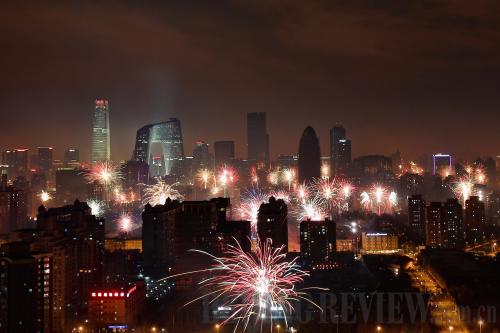|
 |
|
CITY IN SMOKE: Fireworks illuminate the skyline to celebrate Chinese Lunar New Year, causing severe air pollution in Beijing on February 9 (CFP) |
Creeping smog put a damper on Lantern Festival celebrations on February 24, made worse by thick fog shrouding most parts of north and east China that lowered visibility to under 1,000 meters. Traditionally, the Lantern Festival, celebrated on the 15th day of the first month in the Chinese calendar, marks the end of celebrations for the Spring Festival, or the Lunar New Year, which fell on February 10 this year.
Prolonged smog has tormented Chinese people in the early part of 2013. In the first month of the year, Beijing experienced 25 smoggy days, 13 more than the average of the same period over the previous 10 years.
The average density of PM2.5 tiny airborne matter in January was 180 micrograms per cubic meter in Beijing, about 30 percent higher than the same period between 2009 and 2011, according to official data. PM2.5 refers to fine particulate matter that is 2.5 microns or less in diameter. It is extremely hazardous to respiratory and cardiovascular systems, especially among children and the elderly.
Furthermore, recent research by the Chinese Academy of Sciences (CAS) found a large amount of organic nitrogen compounds in the recent smog that engulfed Beijing and nearby cities. The chemicals are believed to have been major components in London's Great Smog in 1952 and the photochemical smog in Los Angeles from 1940 to 1950.
In the wake of the serious situation, authorities and the public have begun to take action.
A 'greener' festival
For the first time, Xu Xiliang decided to push aside the idea of setting off fireworks to celebrate the Spring Festival with family. In the past eight years since 2005, when Beijing lifted a 12-year-long firework ban, the 36-year-old Beijinger spent more than 1,000 yuan ($161) for fireworks each year.
"I haven't experienced so many smoggy days in the past. I hope my efforts can contribute to easing the problem," Xu said.
Chinese people ring in the Lunar New Year with a huge amount of firecrackers and airborne fireworks. Custom dictates that the loud noises and vibrant sparks ward off evil spirits and bad luck.
The pyrotechnic spree is always accompanied by a rise in pollution and a spate of accidents including burns and fires.
According to the Ministry of Environmental Protection, during the weeklong Spring Festival holiday from February 9 to 15, PM2.5 readings skyrocketed in many Chinese cities, indicating worsened air quality attributed to fireworks.
Of the 74 cities that had applied a more comprehensive air quality monitoring standard and published daily reports on PM2.5 by the end of 2012, 42.7 percent reported excessive readings during the Spring Festival holiday.
The highest average single-day reading reached 426 micrograms per cubic meter, nearly 5.7 times the country's standard of 75 micrograms per cubic meter, the ministry said.
Fortunately, more people like Xu realized the severity of the problem and looked to celebrate the holiday in a more environmentally sound fashion by setting off fewer fireworks.
As a result, the sales of fireworks dropped significantly around the country.
In Beijing, a total of 313,000 cartons of fireworks were sold from February 9 to 14, down by 45 percent from the 564,000 cartons sold during last year's Spring Festival, according to statistics from the Office on Fireworks and Firecrackers of the Beijing Municipal Government.
In a report by The Beijing Times, a spokesman for the Beijing Fireworks Co. was quoted as saying that its sales had plunged 30 percent. A fireworks salesman in Taiyuan, north China's Shanxi Province, reported an identical decline in holiday sales.
Meanwhile, less fireworks refuse was collected.
According to official statistics, sanitation workers in Beijing cleared 5,283 tons of fireworks waste during the Spring Festival holiday, 332 tons less than last year.
In Shanghai, the amount of Lunar New Year's Eve fireworks refuse decreased to 700 tons this year from 970 tons in 2012, according to the municipal sanitation department.
Apart from ordinary residents, government officials also seized the opportunity to promote environmentally friendly behavior. The Beijing Municipal Government sent the city's residents text messages reminding them to set off fewer fireworks this year. It also issued a "fireworks index" that indicated whether outdoor conditions are suitable for fireworks.
Meanwhile, Beijing also reduced the number of franchised firework shops to 1,337 from last year's 1,429. Only 750,000 cartons of fireworks were put on sale this year, down from 810,000 in 2012.
| 